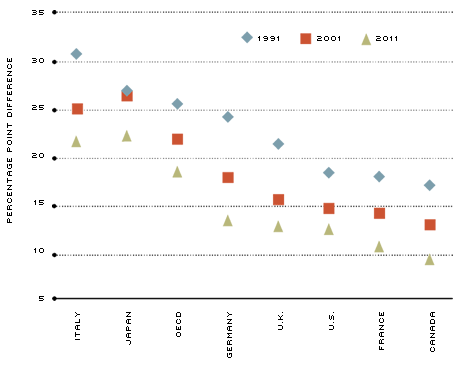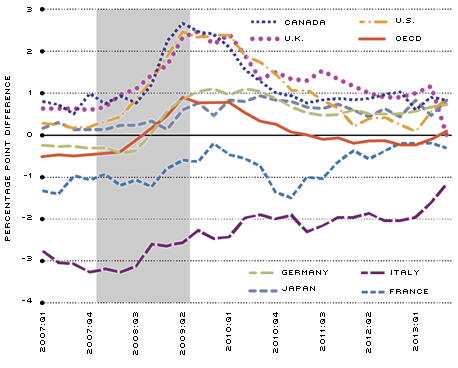Around the World, Gender Gaps Ebb and Flow
Labor market dynamics are different for men and women. In the United States during the 2007-09 recession, men took a particularly hard hit and experienced a stronger recovery from the trough—two phenomena sometimes labeled "man-cession" and "he-covery." Although these differences appeared unusual during the crisis, recent research suggests that these patterns were by no means unique to the Great Recession but were similar to the labor market dynamics for men and women observed over the past 30 years.
But what about in other countries? This article compares these phenomena in more-recent years across advanced economies in the Organization for Economic Cooperation and Development (OECD) with a focus on the Group of Seven (G-7) countries: Canada, France, Germany, Italy, Japan, the U.K. and the U.S.
Labor Force Participation Rates
The labor force participation rate is defined as the ratio of the labor force to the working-age population.[1] As of 2011, the last year for which we have comparable data for all countries, the participation rates for men and women were 70.1 percent and 57.5 percent in the U.S. and 69.5 percent and 50.9 percent in the OECD.[2] The U.S. labor participation rate for women steadily increased after World War II but started to flatten out in the early 1990s; the rate for men constantly declined. In the OECD, for which data are available only since 1990, the trends were perhaps less marked but similar, in the sense that they showed a convergence between the two genders.
Naturally, there were differences across countries even within this relatively homogeneous group. Figure 1 compares the evolution of the gender gap in labor force participation—the difference of labor force participation rates for men and for women—in the U.S., OECD countries as a group and individual G-7 countries from 1991 to 2011.
Gender Gap in Labor Force Participation, 1991-2011

SOURCE: World Bank.
NOTE: The gap in labor force participation rates between men and women has been shrinking, in general. In Italy, for example, the participation rate was more than 30 percentage points higher for men than for women in 1991; by 2011, that gap had shrunk by about 10 percentage points.
Two facts stand out: 1) in the long run, female labor participation increased in all countries; 2) while these countries shared a similar trend, there were considerable differences. The U.K., the U.S., France and Canada had relatively smaller gender gaps, which became smaller over time. Germany, Italy and the U.K. showed the largest improvements in the gap, while Japan's was relatively static. These diverse changes depended both on initial conditions (some countries had small gender gaps at the beginning of this period) and on labor market incentives, human capital accumulation and cultural attitudes.
Unemployment Rates
What about unemployment rates? Here, we considered the difference between the unemployment rate for male and female workers since 2007 and its relationship with labor force participation.
In the U.S., both genders experienced severe labor market adjustments, with a contraction of total labor participation and a sharp increase in unemployment rates. The contraction of total labor participation is due mostly to the fact that the male participation rate dropped by 1.1 percent, while the female participation rate remained stable, two facts consistent with long-term trends. The larger number of jobs lost by men in 2008-09 quickly caused the male unemployment rate to peak at 11.2 percent in October 2009, a stark increase of 6.4 percentage points relative to November 2007, while the female unemployment rate increased less, from 4.6 percent to 8.7 percent (a difference of 4.1 percentage points) over the same period. Finally, the recovery brought faster job growth for men than for women.
The initial widening followed by a narrowing of the gender unemployment gap is not unique to the recent recession but a more general feature of the labor market in the U.S. in recession times.
Gender Gap in Unemployment Rate by Country

SOURCE: Organization for Economic Cooperation and Development (OECD).
NOTE: The data points correspond to the difference in men's unemployment rate and women's unemployment rate in each country (men's minus women's). Any line above the 0 line indicates that men had a higher unemployment rate; below 0 indicates that women had a higher unemployment rate. For example, in Canada in 2009:Q2, the men's unemployment rate was 2.7 percentage points higher than the women's. In Italy in 2007:Q4, the women's rate was more than 3 percentage points higher than the men's. The gray bar denotes the latest recession.
What happened in other countries during the same period? OECD and G-7 countries showed similar labor market adjustments. Figure 2 shows the unemployment rate differences between men and women by country.[3] In all countries, the men's unemployment rate increased greater than the women's, which is reflected by the upward trend in the unemployment gap during the recession. In other words, men were impacted more severely during the recession than women. Afterward, some countries rebounded while others maintained their relatively large gaps, particularly the countries that had a slow recovery, if any.
Why are changes in the unemployment rate different for men and women during recessions? The roles played by men and women in the labor force help to explain these facts. Theories of brain-based technological change suggest that men and women are not perfect substitutes in all occupations. Although men are endowed with the same brain abilities (used for mental labor) as women are, men have the advantage in brawn abilities (used for physical labor). When technological change is biased in favor of brain-intensive activity—as it arguably has been over the past 50 years—and labor market institutions favor entry of women into the labor force, there tend to be more women in brain-intensive occupations and industries in which women can specialize according to their comparative advantage. Although this bias did contribute to increased female labor participation, it also sustained a large heterogeneity in female-to-male worker ratios across occupations and sectors, as different sectors mix various occupations differently.
In the U.S., the male labor force was hit harder during the recent recession because more jobs were lost in occupations and sectors that traditionally employ more men and are cyclically sensitive, particularly manufacturing and construction.[4] Women, on the other hand, tend to occupy a large share of employment in industries that are largely resistant to downturns, industries such as education and health care. This explains a large part of the difference between the unemployment rates of men and women in the U.S. since 2007 and also in other countries. Within the G-7, the countries that had the smallest gender participation gaps also experienced larger unemployment increases for men than for women because the two genders are more likely to work in industries in which they can exploit their comparative advantage.
English-speaking countries (the U.K., the U.S. and Canada) and, to a lesser extent, France and Germany, experienced a simultaneous increase in unemployment that affected men disproportionately. But after the peak of the crisis, these differences were at least partly reduced. In France, the unemployment rate has been consistently larger for women, though there was some cyclical variation consistent with what was happening in the other countries. In Italy and Japan, we did not observe the inverted U-shaped curve of the unemployment rate gender gap during recessions, perhaps because in these countries the relatively low participation rate of women did not allow them to specialize in relatively acyclical industries (such as health care and education) as much as women did in other countries.
Why is this cross-country evidence important? Some of the cross-country differences in unemployment rates are explained by differences in women's unemployment rate, and this is affected by labor force participation. Therefore, policies that affect female labor participation (such as maternity leave regulation or the marginal taxation of second earners) affect the way women select into certain occupations and sectors, which in turn affects the unemployment rates of the two genders. Although these policies tend to reflect societal and cultural preferences, in several countries there may be room for changes. More generally, economic theory and recent evidence suggest that allowing specialization according to comparative advantage by gender may bring quantitatively important welfare gains, as it has in the U.S. since the 1960s.
Endnotes
- Although the working-age population is considered to be 16 and older in the U.S., 15 and older is used in many other countries and is used by the OECD. Therefore, 15 was used as the cutoff for all countries' data in this article so that like comparisons could be made. [back to text]
- The OECD is made up of 34 countries. [back to text]
- The unemployment rate for men minus the unemployment rate for women. [back to text]
- Data from the Bureau of Labor Statistics (BLS) show that in 2007 the female labor share in the manufacturing, transportation and utilities, mining, and construction sectors was about 30 percent, 24.5 percent, 13.7 percent and 9.4 percent, respectively. Female labor shares in other sectors are above 40 percent. The total employment of these four sectors accounts for about one-third of total nonfarm employment, and the drop in employment in these four sectors during the recent recession was significant: 14.7 percent, 6.8 percent, 7.4 percent and 19.8 percent, respectively. [back to text]
References
Albanesi, Stefania; and Sahin, Aysegül. "The Gender Unemployment Gap." Federal Reserve Bank of New York Staff Reports No. 613, April 2013.
Hoynes, Hilary; Miller, Douglas L.; and Schaller, Jessamyn. "Who Suffers during Recessions?" Journal of Economic Perspectives, Summer 2012, Vol. 26, No. 3, pp. 27-48.
Contessi, Silvio; and Li, Li. "From 'Man-Cession' to 'He-Covery': Same Old, Same Old." Federal Reserve Bank of St. Louis Economic Synopses, 2013, No. 3. See http://research.stlouisfed.org/publications/es/article/9622.
Views expressed in Regional Economist are not necessarily those of the St. Louis Fed or Federal Reserve System.
For the latest insights from our economists and other St. Louis Fed experts, visit On the Economy and subscribe.
Email Us

